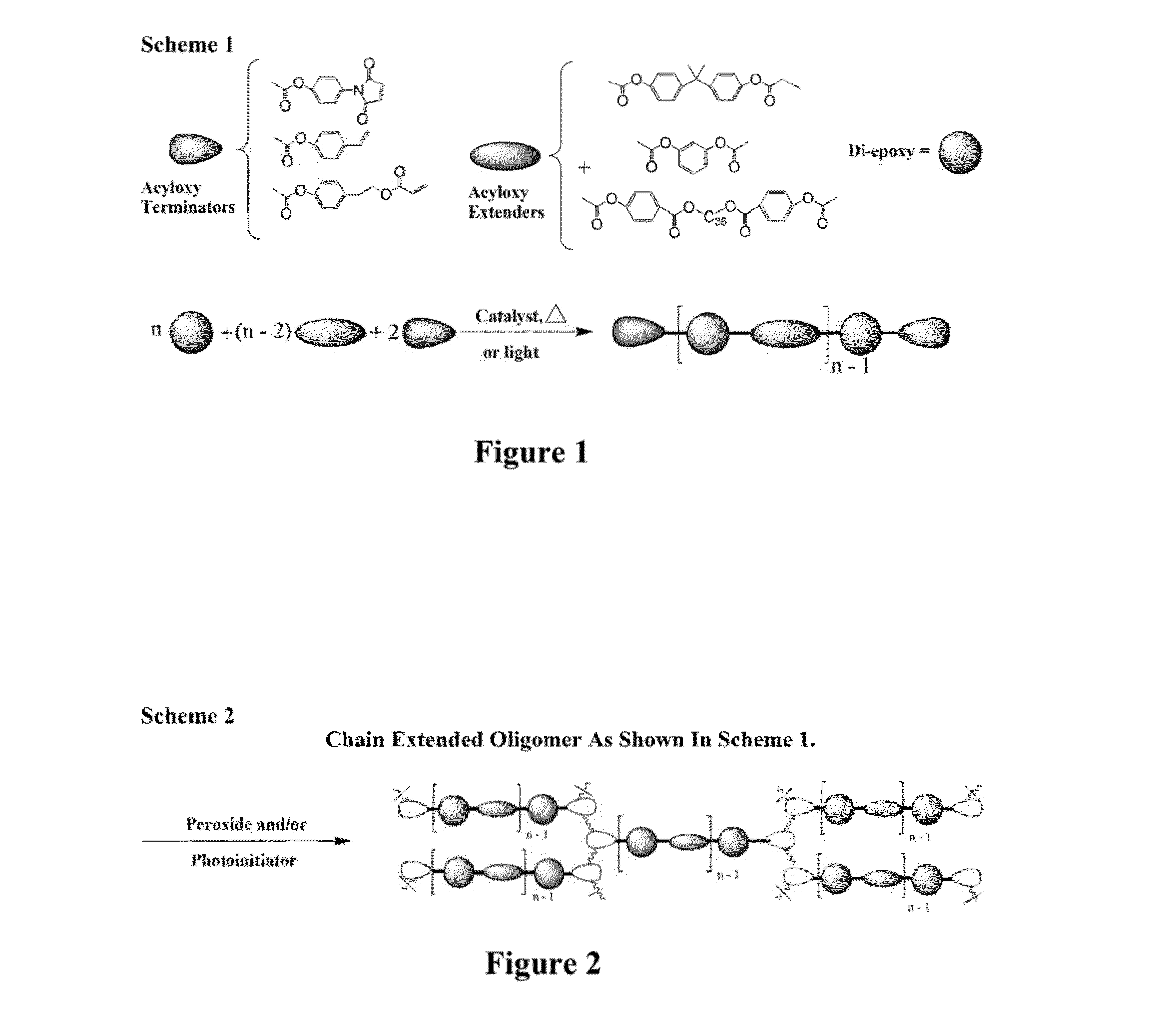Curatives for epoxy compositions
- Summary
- Abstract
- Description
- Claims
- Application Information
AI Technical Summary
Benefits of technology
Problems solved by technology
Method used
Image
Examples
example 1
Preparation of a Phenol Functional Curative
[0161]
[0162]A 500 mL, 2-neck flask was charged with 44.27 g (0.2 mole) 3-aminopropyl triethoxysilane, and 20.79 g (0.21 mole) butyl-4-hydroxybenzoate. The flask was equipped with a Dean-Stark trap condenser and bubbler. The mix was then stirred magnetically and heated at 170° C. under an argon blanket for 41.25 hours. Approximately 18.0 mL of butanol was collected in the trap (theoretical yield=18.3 mL). The mix was sparged with argon at 170° C. for 45 min. The product was poured out of the container while still hot. It was a very viscous amber liquid at room temperature. A total of 65.6 g of product was recovered (96.0% of theoretical yield). An FTIR run on this compound had a broad —OH absorbance as well as strong absorptions at 2930, 1688, 1605, 1531, 1270, 1162, 1073, 953, 848, and 769 wavenumbers.
example 2
Preparation of a Phenyl Acetate Curative / Coupling Agent
[0163]
[0164]A portion of the compound obtained as described in EXAMPLE 1 was converted to the phenyl acetate shown above. A 250 mL flask was charged with 37.15 g (0.11 mole) of the compound from EXAMPLE 1, 11.02 g (0.11 mole) acetic anhydride, and 0.1 g of dimethylaminopyridine. This mix was heated and stirred at 90° C. for 2 hours. The acetic acid side product was then removed via rotary evaporation and sparge. The final product weighted 40.5 g (97% of theoretical yield). An FTIR spectrum of this material revealed a small amide N—H stretch at 3318 along with prominent absorptions at 2934, 1760, 1639, 1501, 1268, 1198, 1073, 913, and 762 wavenumbers.
example 3
Comparison of Epoxy Formulations Containing Phenol Functional Curative to the Corresponding Phenyl Acetate
[0165]The following example demonstrates the remarkably improved adhesion for an epoxy resin cured using an acyloxy coupling agent from EXAMPLE 2, versus the analogous phenol-functional coupling agent from EXAMPLE 1, which does not contain the acyloxy moiety.
TABLE 1Properties of Epoxy Formulations Containing a Phenol FunctionalCurative and Corresponding Phenyl AcetateCompositionFormulation 1Formulation 2Tactix 756 epoxy31.6%31.6%Ricon15.2%15.2%Terpineol36.7%36.7%Curezol 2MA1.1%1.1%Silica1.1%1.1%EXAMPLE 1 compound2.1%0.0%EXAMPLE 2 compound0.0%2.1%Adhesion*, kg force11.131.5(300 × 300 Si on ceramic@260° C.-175° C. 60 minramp cure + 4 hour PMC)*The die-shear adhesion was measured as kg force on a Dage Series 4000.
[0166]The phenyl acetate functional coupling agent had almost three times the 260° C. adhesion of its phenol functional counterpart. Even at a relatively low percentage of...
PUM
| Property | Measurement | Unit |
|---|---|---|
| Hydrophilicity | aaaaa | aaaaa |
| Temperature | aaaaa | aaaaa |
Abstract
Description
Claims
Application Information
 Login to View More
Login to View More - R&D
- Intellectual Property
- Life Sciences
- Materials
- Tech Scout
- Unparalleled Data Quality
- Higher Quality Content
- 60% Fewer Hallucinations
Browse by: Latest US Patents, China's latest patents, Technical Efficacy Thesaurus, Application Domain, Technology Topic, Popular Technical Reports.
© 2025 PatSnap. All rights reserved.Legal|Privacy policy|Modern Slavery Act Transparency Statement|Sitemap|About US| Contact US: help@patsnap.com



